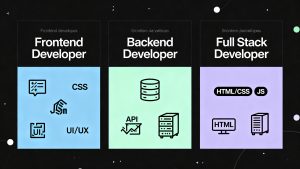Websites are the front door to your applications and backend services. It’s the first thing a user sees about your business. The web isn’t just about rendering text and images anymore, today’s sites handle complex frontend logic and deliver fully customized experiences.
A monolithic frontend can work fine on a small scale, but once you grow, you might want to split your frontend into smaller, domain-specific modules, each owned and deployed by an independent team. That is where micro frontends come into the picture.
In this blog, we will look into everything that you need to know about micro frontend architecture. So let’s get started
What Are Micro Frontends
Micro frontends is a software architecture in which, which a web application’s frontend is decomposed into loosely coupled, independently deliverable fragments
Think of micro frontends as microservices but for frontends. Just as microservices decouple the backend into discrete services, micro frontends decouple the UI into self-contained modules that can be integrated at runtime or build time.
One of the major advantages of a micro-frontend architecture is that each team can choose its technology stack and work independently of the others. For example, one team might build its feature in React while another uses Angular, and both can coexist seamlessly in the same application.
Why Use Micro Frontends?
Micro Frontends gives you a lot of advantages compared to traditional monolithic architecture. Some of the advantages of micro frontends are as follows:
Scalability
One of the key advantages of micro-frontends is that you can independently scale only the parts of your UI that experience heavy traffic. For example, in a trading application, you might notice that the real-time chart and order-book components spike in usage during market opening and closing, while portfolio-management or account-settings pages see far less load. You can independently scale the frontends which are expected to have heavy loads rather than scaling the whole frontend.
Faster Development Cycles
Since there’s minimal or no dependency between frontends, you can easily develop new features or fix bugs. With independent release cycles, each team can roll out fixes or features on its own, with no need to wait for a full app-wide update. That means you get those changes in front of users faster, gather feedback sooner, and stay more responsive to their needs.
Technology Diversity
Different features may have unique requirements. One team might need a data visualization library supported best by React, while another prefers the structure of Angular. Micro frontends permit polyglot architectures, letting each team pick the right tool for the job.
Maintainability
With micro-frontends, each team only includes the code needed for its own module. This keeps the codebase clean, simplifies maintenance and debugging, and lets you add new features directly, without risking unintended side effects in any other part of the application.
Micro Frontends vs Monolithic Frontends
With monolithic frontends, all UI components and business logic live in a single, tightly coupled codebase. There is a significant difference in how we approach both. Let’s look into those:
- Codebase: Monolithic frameworks have a single main repository wherever developers work together. In the case of micro frontends, there will be different repositories or they will be under different packages. There will be a clear separation of concerns in a micro frontend architecture.
- Deployment: Monolithic frameworks have one deployment for the whole UI. Whereas in micro frontends, we have multiple independent deployments per feature.
- Technology Choices: Monolithic apps will have a specific tech stack they use like React, Vue or Angular. Whereas in micro frontends, it can depend on the team. Teams can either use the same tech stack or choose the one that feels right.
- Scalability: If we want to scale a monolithic app, we need to scale the entire app. In a micro frontend architecture, we can scale per module or feature independently.
- Risk Tolerance: Moolthic apps can have a single point of failure for releases, whereas, in micro frontends, the risk is isolated to a specific module.
- Complexity: In monolithic apps, initial setups are easy. But whenever the codebase grows, it will be hard to track the project. In a micro frontend architecture, the setup is complex as all frontends have to be coordinated accordingly. But it improves the developer experience in the long run.
Key Architectural Concepts
Micro-frontend architecture is all about breaking a large UI into independently developed, deployed, and maintained pieces. These foundational concepts ensure each module can truly operate on its own while still fitting seamlessly into the overall user experience
Composition
Composition is basically how you put together different pieces of your website that were built separately by different teams.
There are a few ways to combine your application:
- Client-Side Composition:- Your web browser does the assembly work. The main website downloads all the separate pieces and puts them together right in your browser, like downloading different apps and running them all at once.
- Edge-Side Includes (ESI): You can use CDNs that put the pieces together before sending the complete page to your browser.
- Server-Side Composition: The main server combines all the pieces into one complete webpage and sends that finished page to your browser.
- Build-Time Integration: All the pieces get combined during development before the website goes live. This creates one big file with everything included which lifts the heavy lifting.
Routing
Routing is how your website figures out which page to show when someone clicks a link or types in a URL.
With micro frontends, you have a few simple options:
- Path-based routing: Give each team their section of the website. Team A handles /shopping/*, Team B handles /checkout/*, etc.
- Central router: One main system decides which team’s code should handle each page, like a traffic director.
- Load balancer routing: Your load balancer can look at the URL and send requests to the right micro frontend service. For example, /api/users/* goes to the user service, /api/orders/* goes to the order service.
- Edge routing” Special servers rewrite URLs to point to the correct micro frontend before your browser even sees them.
Shared Dependencies
To prevent duplicate downloads and version conflicts in your app, you can:
- Share common libraries: Use tools like Webpack Module Federation or import maps to share libraries (React, Lodash) across teams rather than bundling separately.
- Maintain version alignment: Ensure compatible library versions across micro frontends or implement adapters to prevent runtime errors.
This reduces bundle size and eliminates redundant code while maintaining system stability.
Communication
Cross-micro frontend communication should be minimized, but when necessary:
- Use browser events or a shared event bus to publish and subscribe to events.
- Leverage state management solutions (e.g., Redux store per micro frontend, with synchronized stores via a central broker).
- Also, make use of URL-based communication (passing state via query parameters) for decoupling.
Real-World Use Cases of Micro Frontends
Micro frontends are just like any other software development architecture. It is not an all-in-one solution. Understanding when to use the micro frontend will be your first step.
When you have a large application like maybe a banking application, it will have different modules. That’s a perfect use-case scenario of micro frontends. Micro frontends allow each team to work independently on their segment of the app.
Some of the ideal scenarios where you can use micro frontends are:
- Enterprise applications – Banking, insurance, or healthcare platforms with distinct business domains (accounts, loans, payments) that different teams manage.
- E-commerce platforms – Large retailers where separate teams handle product catalogues, checkout, user accounts, and order management.
- Multi-brand companies – Organizations with different brands or regions that need consistent core functionality but unique user experiences.
- Legacy modernization – Gradually replacing monolithic applications by migrating sections to modern frameworks without disrupting the entire system.
- High-traffic applications – Systems that need independent scaling, deployment, and technology choices for different features.
Challenges and Considerations
There are scenarios where a micro frontend architecture might be an overkill. For small and medium-scale applications that are used by maybe less than 10K users (not a standard number), the traditional monolithic application can be best suited.
Some of the key considerations that you should know are:
- Complexity: Instead of handling one application, you need to handle monitoring and scaling a set of micro frontends. Also, local development can also have some trouble during the initial setup and it’s non-trivial.
- Performance Trade-offs: Fetching multiple bundles can hurt First Contentful Paint (FCP), which is a KPI that Google and other search engines use to rank websites. You can mitigate it with prefetching and shared dependency bundles.
- Shared State and Consistency: There might be scenarios where you can’t independently handle micro frontends if there are some logical connections between two micro frontends. There should be an effective communication method between micro frontends to work effectively. This can sometimes cause issues when you have like if one micro frontend depends on another, dependency changes can affect it.
Micro Frontends Best Practices
Some of the best practices that you should if you are going with a micro frontend are:
Know your boundary
You should define what can be logically isolated and what cannot be. You should split micro frontends along clear business or domain boundaries (shopping cart, user profile, payment) to minimize inter-module dependencies.
Design System and Shared Components
Maintain a common design system library, versioned and published to an internal registry, so that typography, colours, and UI primitives remain consistent across modules. This prevents your app from looking like it was built by five different teams. Think of it as your brand’s style guide that everyone follows to keep things looking professional and cohesive.
Optimize for performance
Nobody wants to wait around for your app to load. Smart loading keeps users happy under the pressure of serving massive bundles to everyone at once.
You can implement strategies like lazy-loading, prefetching, caching and other methods to reduce the load time and have a good user experience.
Graceful Degradation
Design fallbacks when a micro frontend fails to load. The main application should capture errors and display static content to maintain usability. Nobody likes staring at a blank screen wondering if their internet broke. Build your app like a good backup plan, when one section fails, the rest keeps working so users can still stick to your application.
Conclusion
Thanks for reading this blog. In this detailed tutorial, we have covered almost everything that you need to know to start creating your first micro frontend application.
Throughout this blog, we have discussed all the strategies that you should use to make your application have user-friendly behaviour. We have also looked into the considerations that we should make when implementing micro frontends, from composition patterns to performance optimization. Now you know how to implement micro frontends effectively.
Keep learning.



